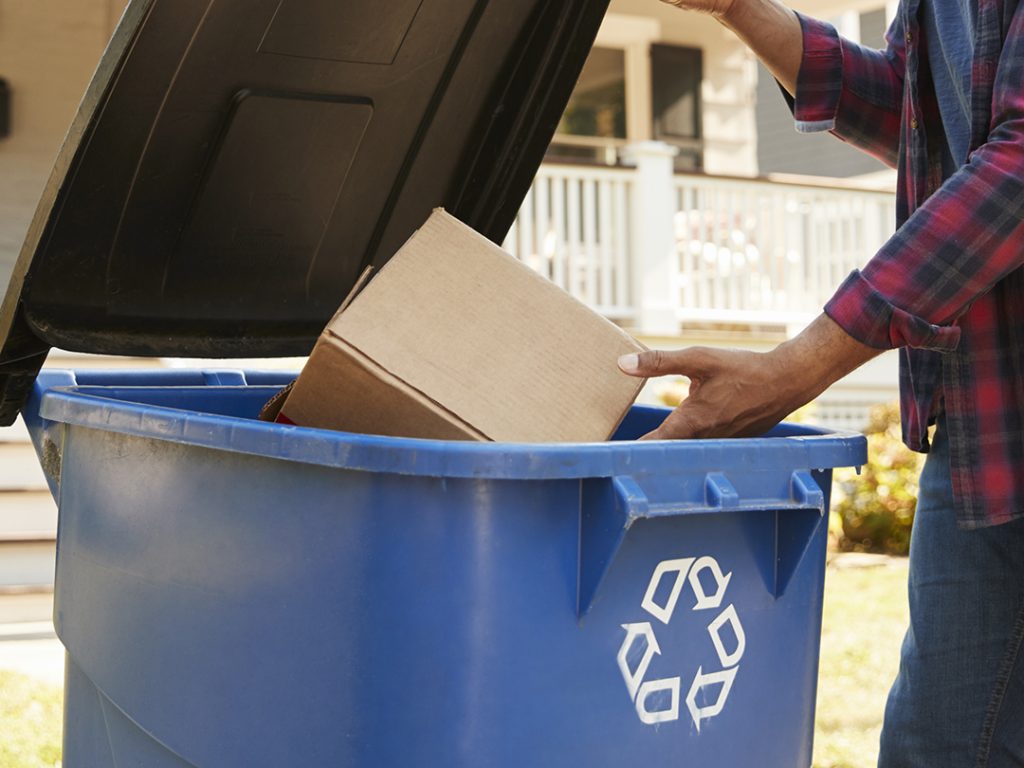
You might want to double-check what you toss in the blue recycling bin the next time you take out the trash.
Clovis is recycling more than ever before, about 10,000 tons each year, according to Clovis Assistant Public Utilities Director Glenn Eastes. But Clovis residents are throwing more than just recyclables in the blue bin.
“We have a bad contamination problem. If a load is contaminated it ends up going straight to the transfer station and then they dump it,” Eastes said.
California law AB939, also known as the California Integrated Waste Management Act, mandates that Clovis divert 50 percent of its waste from landfills. Most of that diverted waste is recycled. Though it is not mandated, the state aims to recycle 75 percent of its waste by the end of this year, per the 75 Percent Initiative that was enacted by Governor Jerry Brown in 2011.
Anniemarie Shelton, a recycling coordinator with Republic Services, which is contracted to handle waste disposal in Clovis, explained how contamination negatively affects recycling efforts.
“Contamination affects the overall cost and sustainability of recycling. Contamination can lower the quality of the material, lowering the value and marketability, and makes processing recyclable materials even more difficult and more expensive,” she said. “Contamination leads to lower material value and increases processing, compounding the issue the recyclable material markets are facing.”
Shelton said an estimated 12 percent of all loads that come from Clovis are contaminated.
“Contamination rates vary greatly from jurisdiction to jurisdiction and from recycling program to program,” Shelton said. “Clovis contamination rate on our residential program is just under 12% and, although compared to other jurisdictions serviced by Republic, this is not bad, we would like to see that number go down.”
The main cause of contamination is “wish-cycling,” Shelton said.
“Republic Services has found that the contributing problem to contamination is ‘wish-cycling’ – throwing items in their recycling bin that they hope can be recycled. That makes the contamination problem worse,” she said.
Contaminants such as food can contaminate entire trucks of recyclables. If a load is contaminated it gets dumped in landfill, wasting an entire truck’s worth of recyclables.
Eastes said food waste is the most common contaminate.
“Food products are common contaminants. That’s what’s going to damage the paper recycling product,” Eastes said. “Paper is the majority – weight wise – of what we recycle. So it makes up 50 percent of the material that is being recycled.”
Even half full containers of liquid can contaminate entire loads.
“Let’s say someone dumps like a carton of milk or some bottle that still holds fluid. That contaminates the entire truck,” he said. “When the truck dumps that day they are going to say ‘Hey, this is contaminated so we’re going to dump it in a different spot and they are probably going to take it straight to the landfill.’”
Other common contaminants include electronic miscellaneous items such as batteries, phones and laptops.
“Phones, batteries, things like that, we don’t allow any of those in the system we have,” Eastes said. “That stuff is hazardous waste and the county has a hazardous waste facility at the American Avenue landfill. On Saturday they take those things for free.”
Fortunately, Republic Services has methods of dealing with these types of contaminants.
Once recyclable waste in Clovis is collected, it is sent to Republic Services’ Newby Island Resource Recovery Park, located north of San Jose.
This is where machines and humans sort the waste into different categories, such as cardboard and plastic.
“At the recycling facility they have a series of magnets and conveyors and optical sorters and things like that to try to deter all that electronic stuff.” Eastes explains. “They have man sorters to – people trying to pull stuff out. So the waste is running down the conveyors and they’re pulling out cardboard, then it goes to another conveyor and they’re pulling out metal with magnets. Then whatever is left goes to the optical machines and that thing is shooting different types of plastic everywhere. What’s left that bypasses all of those is the residual – stuff that they didn’t want.”
While contaminates such as batteries may not contaminate entire loads like food waste, it is still important to dispose of it properly because it is considered hazardous waste. If hazardous waste is improperly disposed of, it has a greater chance of being left in landfill where it can pose a danger to wildlife or nearby people.
Safe recyclables include paper, cardboard, glass, plastics, and aluminum or metal cans.
The City of Clovis has online resources for residents unsure of what is recyclable and what is not.
Eastes said the city is increasing community outreach in an effort to spread awareness about contamination.
“We get a lot of calls from the public on certain items. We’re trying to get those on our webpage. We’re also trying to do social media outreach, that way if we get a lot of calls we’ll try to do a little education piece so that gets out to the public,” he said.
Shelton said preventing contamination is as simple as following a three-step process.
“Know what to throw. Make sure recyclables are empty, clean and dry. Don’t bag it. And keep your recyclables loose and never put them in bags or containers,” Shelton said. “When it comes to recycling, everyone has a part to play. Working together, we can make sure recyclable materials don’t end up in our landfills.”
Learn more about how you can prevent contamination at www.recyclingsimplified.com.








